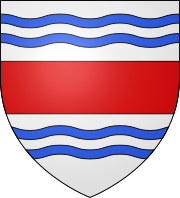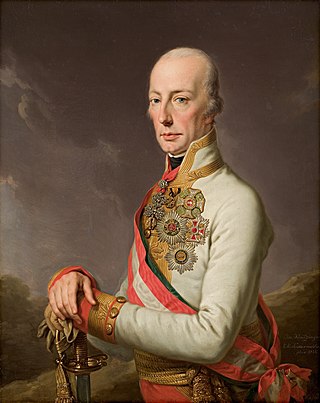
Francis II and I was the last Holy Roman Emperor as Francis II from 1792 to 1806, and the first Emperor of Austria as Francis I from 1804 to 1835. He was also King of Hungary, Croatia and Bohemia, and served as the first president of the German Confederation following its establishment in 1815.

Dauphin of France, originally Dauphin of Viennois, was the title given to the heir apparent to the throne of France from 1350 to 1791, and from 1824 to 1830. The word dauphin is French for dolphin and was the hereditary title of the ruler of the Dauphiné of Viennois. While early heirs were granted these lands to rule, eventually only the title was granted.

Count is a historical title of nobility in certain European countries, varying in relative status, generally of middling rank in the hierarchy of nobility. Especially in earlier medieval periods the term often implied not only a certain status, but also that the count had specific responsibilities or offices. The etymologically related English term "county" denoted the territories associated with some countships, but not all.
Margrave was originally the medieval title for the military commander assigned to maintain the defence of one of the border provinces of the Holy Roman Empire or a kingdom. That position became hereditary in certain feudal families in the Empire and the title came to be borne by rulers of some Imperial principalities until the abolition of the Empire in 1806. Thereafter, those domains were absorbed into larger realms or the titleholders adopted titles indicative of full sovereignty.
Fürst is a German word for a ruler as well as a princely title. Fürsten were, starting in the Middle Ages, members of the highest nobility who ruled over states of the Holy Roman Empire and later its former territories, below the ruling Kaiser (emperor) or König (king).
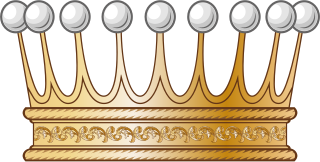
Graf is a historical title of the German nobility and later also of the Russian nobility, usually translated as "count". Considered to be intermediate among noble ranks, the title is often treated as equivalent to the British title of "earl".

King of the Romans was the title used by the king of Germany following his election by the princes from the reign of Henry II (1002–1024) onward.
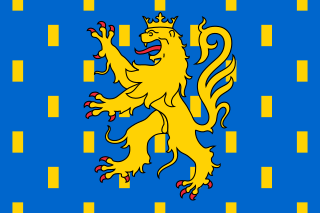
The Free County of Burgundy was a medieval feudal state ruled by a count from 982 to 1678. It was also known as Franche-Comté, from French: franc comte meaning 'free count', and was located in the modern region of Franche-Comté. It bordered the Duchy of Burgundy to the west, which was part of France from 843.
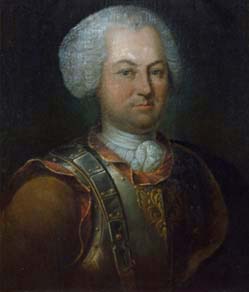
Major-General Granville Elliott, 1st Count Elliott, was a British military officer who served with distinction in several other European armies and subsequently in the British Army. He fought at the Battle of Minden where he was wounded, dying of his injuries several weeks later.
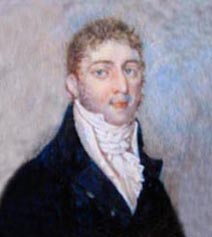
Francis Perceval Eliot was an English soldier, auditor, and man of letters. In 1814 he succeeded his half-brother as Count Eliot, however he did not feel it was proper to assume the title.

Antoine, known as the Good, was Duke of Lorraine from 1508 until his death in 1544. Raised at the French court, Antoine would campaign in Italy twice: once under Louis XII and the other with Francis I. During the German Peasants' War, he would defeat two armies while retaking Saverne and Sélestat. Antoine succeeded in freeing Lorraine from the Holy Roman Empire with the Treaty of Nuremberg of 1542. In 1544, while Antoine suffered from an illness, the Duchy of Lorraine was invaded by Emperor Charles V's army on their way to attack France. Fleeing the Imperial armies, Antoine was taken to Bar-le-Duc where he died.

The House of Lorraine originated as a cadet branch of the House of Metz. It inherited the Duchy of Lorraine in 1473 after the death without a male heir of Nicholas I, Duke of Lorraine. By the marriage of Francis of Lorraine to Maria Theresa of Austria in 1736, and with the success in the ensuing War of the Austrian Succession (1740–1748), the House of Lorraine was joined to the House of Habsburg and became known as the House of Habsburg-Lorraine. Francis, his sons Joseph II and Leopold II, and his grandson Francis II were the last four Holy Roman emperors from 1745 until the dissolution of the empire in 1806. The House of Habsburg-Lorraine inherited the Habsburg Empire, ruling the Austrian Empire and then Austria-Hungary until the dissolution of the monarchy in 1918.

The County of Bar, later Duchy of Bar, was a principality of the Holy Roman Empire encompassing the pays de Barrois and centred on the city of Bar-le-Duc. It was held by the House of Montbéliard from the 11th century. Part of the county, the so-called Barrois mouvant, became a fief of the Kingdom of France in 1301 and was elevated to a duchy in 1354. The Barrois non-mouvant remained a part of the Empire. From 1480, it was united to the imperial Duchy of Lorraine.
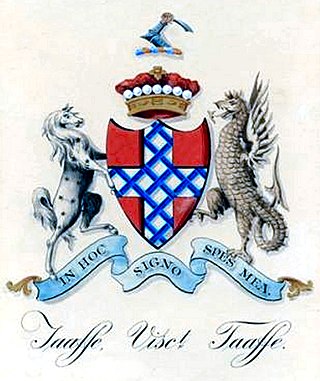
The title Viscount Taaffe, of Corren, was created in the Peerage of Ireland in 1628, together with the subsidiary title Baron Ballymote. From 1661 to 1738, the Viscounts Taaffe were also the Earls of Carlingford.
Jeanne Thérèse du Han de Martigny was born and baptized the same day in Lunéville, in the duchy of Lorraine, now part of France. She was the daughter of Philippe-Louis du Han, comte de Martigny (1678–1733) and his wife Catherine Françoise de Roquefeuil de Puydebar. The Du Han de Martigny were an important noble family of Lorraine, with estates in the north of the duchy.
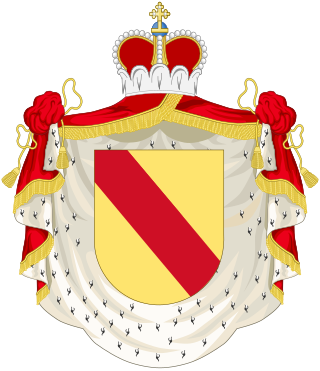
The House of Ligne is one of the oldest Belgian noble families, dating back to the eleventh century. The family's name comes from the village of Ligne where it originated, between Ath and Tournai in what is now the Hainaut province of Belgium.

The Count of Hainaut was the ruler of the county of Hainaut, a historical region in the Low Countries. In English-language historical sources, the title is often given the older spelling Hainault.

Löwenstein-Wertheim was a county of the Holy Roman Empire, part of the Franconian Circle. It was formed from the counties of Löwenstein and Wertheim and from 1488 until 1806 ruled by the House of Löwenstein-Wertheim who are morganatic descendants of the Palatinate branch of the House of Wittelsbach.

The grand title of the emperor of Austria was the official list of the crowns, titles, and dignities which the emperors of Austria carried from the foundation of the empire in 1804 until the end of the monarchy in 1918.

The Eliot family is a British aristocratic family whose members include earls, barons, counts, knights, governors, peers, and Members of Parliament. The main factions are the Earls of St Germans and the Eliot Military Family, which encompasses the Count Eliots.

